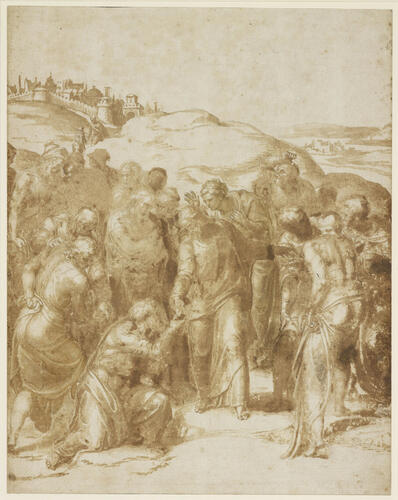-
1 of 253523 objects
The Delivery of the Keys to St Peter c.1555
Brown wash over black chalk; damaged by damp | 36.2 x 28.5 cm (sheet of paper) | RCIN 904814
-
A drawing of Christ handing the keys of the Kingdom of Heaven to St Peter, amongst a crowd of people, in an extensive landscape.
The drawing corresponds with, and is presumably preparatory for, a miniature painting on parchment in the Louvre (3044), identical in size and figural arrangement though with a different landscape setting. The Louvre work is described in Charles Le Brun’s 1671 inventory of the French royal collection as by Giulio Clovio after Michelangelo. The attribution of the present drawing is difficult to judge due to its poor condition, damaged by damp particularly in the central area, but an attribution to Clovio is entirely plausible. It is possible that the composition (and in the case of the Windsor drawing, even the landscape) follows a design by Michelangelo of the Delivery of the Keys, the subject that was initially to be painted on the right wall of the Pauline Chapel in the Vatican. The figures are clearly Michelangelesque, and in bulk and mass are consistent with his style of the mid-1540s. The solemnity and grandeur of the treatment are appropriate, the overall treatment is not dissimilar to the Crucifixion of St Peter as finally executed in that location, and the ratio of height to width of the present work is roughly the same as that of the Pauline frescoes.
That no autograph drawings by Michelangelo can be connected with the composition is not a serious objection, for very few survive by him from this period. But not one of the figures is completely convincing in itself as Michelangelo’s invention. And the composition seems unduly compact: if expanded to the scale of the chapel, the figures would be very much larger than those in the Conversion of St Paul painted on the opposite wall. This objection could be resolved by assuming that Michelangelo’s putative design for the Delivery of the Keys was made in 1542 when the scheme was first broached, and that figure scale and composition were subsequently changed before the subject was abandoned. Alternatively, one might argue that Clovio (or another artist) compressed Michelangelo’s design; but such hypotheses are inherently unsatisfactory and inevitably ad hoc.
If the composition is not derived from Michelangelo, then Girolamo Muziano (1528-92) is a not implausible candidate. His taste for grand compositions is compatible with the present image and he was capable of designing figures in complicated Michelangeleque poses. The composition also echoes the Raising of Lazarus painted by Sebastiano del Piombo partly to Michelangelo’s designs, and Muziano’s admiration for Sebastiano was great. Whereas the landscape in the present drawing is spare and empty, as one would expect from Michelangelo, that in the Louvre miniature is crowded. The Bruegelian features of the landscape would suggest an earliest date for the miniature of 1553, when Pieter Bruegel the Elder and Clovio met, exchanged drawings and collaborated.
(Text adapted from P. Joannides, Michelangelo and his Influence, 1996, no. 62)On the basis of an inscription on its reverse, the Louvre miniature has been attributed to the Genoese painter Giovanni Battista Castello (c. 1510-69). Castello travelled to the court of Philip II in Spain where he painted miniatures after Clovio’s designs for the monastery of San Lorenzo in the Escorial; Clovio had earlier painted miniature for Philip’s father, Charles V, and he may have recommended Castello for this task. See S. Meloni Trkulja, 'La fortuna di Giulio Clovio', in Klovićev zbornik: miniatura, crtež, grafika 1450-1700, Zagreb 2001, pp. 9-15, n. 21.
Provenance
Listed in George III's 'Inventory A,' c.1800-20, p. 44, 'Mich: Angelo Buonarroti. / Tom. I.' (c. 1802): '47. Christ giving the Keys to Saint Peter'. Earlier provenance unknown.
-
Creator(s)
-
Medium and techniques
Brown wash over black chalk; damaged by damp
Measurements
36.2 x 28.5 cm (sheet of paper)
Other number(s)
